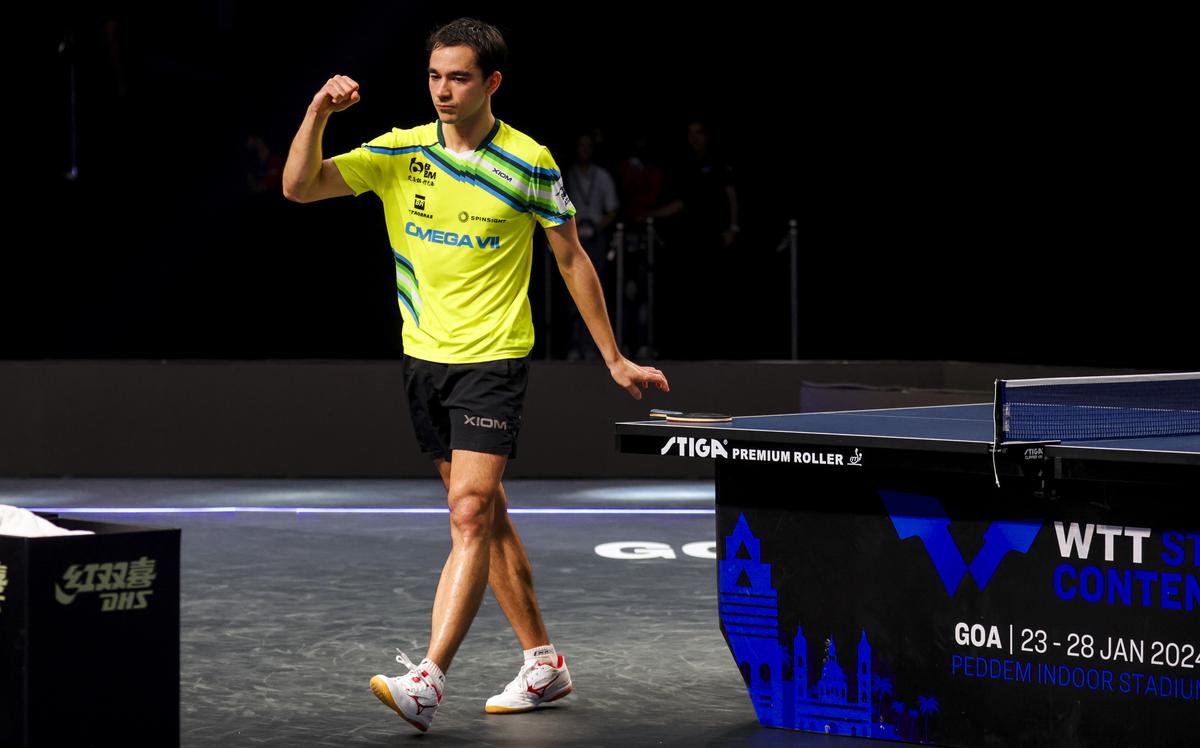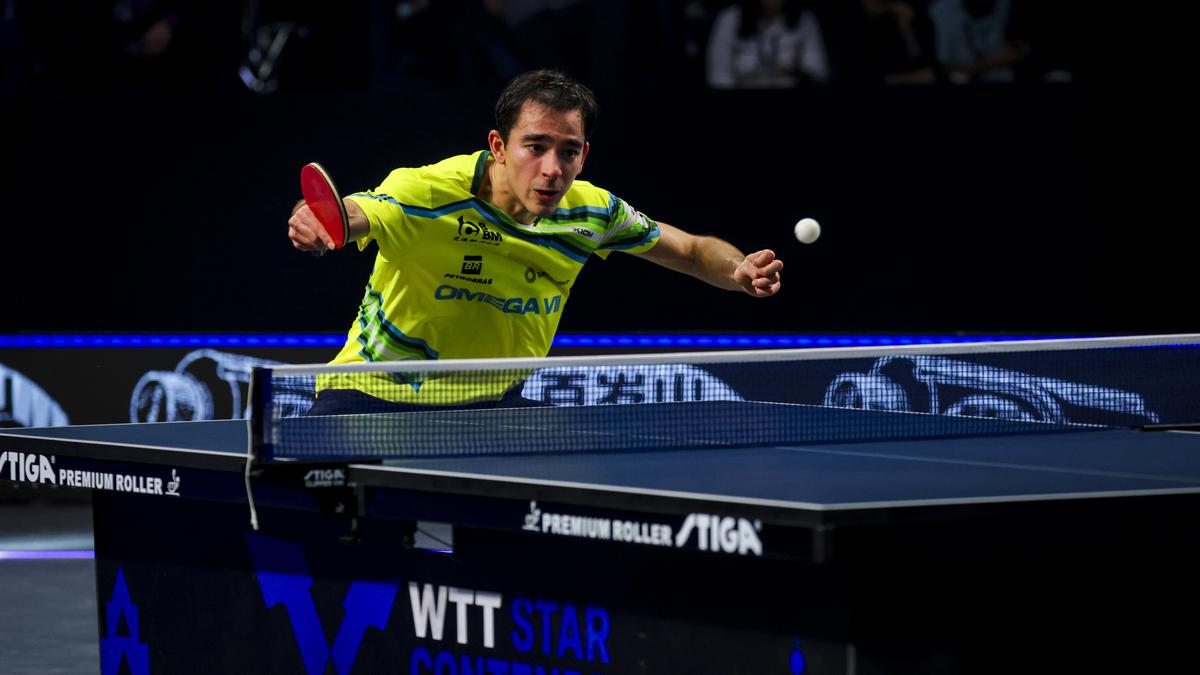Shaker of stereotypes: Hugo Calderano, Brazil’s vegetarian table tennis phenom
At the WTT Star Contender in Goa, Hugo Calderano has a unique habit — He changed his t-shirts at the end of every set. Each time Calderano pulled off his jersey, he’d replace it with an identical yellow and green one. He says he does so to keep his arms as dry as possible and protect the rubber on his bat from picking up any sweat.
Whether or not there’s merit to Calderaon’s theory, and Calderaon swears by it, there’s no doubt it works. Wearing his yellow and green, Calderaon all but lived up to top seeded billing, beating 6 time Olympic medallist Dmitrij Ovtcharov in the men’s singles semifinals before losing a tough six setter to the upcoming Felix Lebrun on Sunday.
A penchant for dry T-shirts isn’t the only unique thing about Calderano though. He also won’t be celebrating his final appearance in Goa– his best result of the year so far — with a barbeque – but probably with a bowl of dal makhani and a garlic naan.
By any means, Calderano doesn’t live up to the stereotype. Hailing from the football crazy, carnivore’s paradise that is Brazil, the 27-year-old from Rio Di Janeiro is a strict vegetarian, table tennis player who’s counted in the top 10 of the world rankings. He’s also a polyglot who speaks 7 languages and a speed cuber who can solve the Rubik’s cube in 9 seconds.
Voting lines now open for Sportstar ACES Awards 2024
“I’ve been vegetarian for 6-7 years now,” says Calderano – the only player from his nation in Goa. “It started after I watched a documentary and started researching the health and performance benefits of becoming vegetarian. It was a bit unusual when I started, but it’s fine now,. ” he says.
If his own career is any example, Calderano makes a strong argument for his dietary choice.
Currently World number 7, Calderano’s – the men’s singles quarter finalist from the 2020 Olympics is counted as amongst the greatest players to have emerged from either of the American continents.
Although Brazil has produced the odd player to have competed at the world level – Hugo Hoyama reached the round of 16 at the 1996 Olympics (his name was mostly used as an in joke in an episode of the American sitcom The Office) – Calderano had no background about the sport as a kid.
“I started when I was 8. I was playing ping pong for fun with my dad. No one I knew had played professional table tennis. My parents were both PE teachers so sport was always in my family,” he says.
No football fan
Unlike most of his compatriots, he wasn’t particularly taken by football. “I was never really into football. I just played for fun like the other Brazilian kids. I was actually a lot more interested in volleyball. It’s actually a very big sport in Brazil. Probably number 2,” he says.
Table tennis he will admit, probably doesn’t rank anywhere close to the top 10. But it’s something he developed a fascination for. “I found that it is a very dynamic sport. I’ve played other sports but table tennis stood out because it’s very dynamic and you have to be creative at the same time. It’s both. You also have to be strong both physically and mentally. I enjoy this combination. I still love volleyball but when I was 12-13 years old I was getting very good at table tennis and I had to choose between it and volleyball. I ended up choosing table tennis,” he says.
ALSO READ | Her roots in Puducherry, Prithvika Pavade is France’s top hope at the Paris Olympics
Although he was undoubtedly talented (In 2010, at the age of 14, he was South American and Latin American Children’s Champion. In 2011, at the age of 15, he was Brazilian Youth Champion, Latin American Children’s Champion, in Peru, individually and in teams; and Champion of the Argentine Open Youth in individual, team and doubles) with only a little public spotlight, Calderano might have struggled in his early pursuit of the sport. Luckily his rise coincided with the Rio Olympics.
“At the beginning you have to invest a little bit. But with the Olympics in Rio, we got a lot of support from the government. We got to go to many training camps in Europe and Asia and that helped me develop,” he says.
Buoyed by a vociferous home crowd, a 20-year-old Calderano would fight his way into the round of 16, and in doing so match Brazil’s best ever achievement. “More and more people started to know me, especially after the Olympics. In Brazil people really enjoy the Olympics and follow every sport. I think with my good results people started to know me,” he says.

Hugo Calderano celebrates after winning a point at WTT Star Contender in Goa.
| Photo Credit:
Special Arrangement
Hugo Calderano celebrates after winning a point at WTT Star Contender in Goa.
| Photo Credit:
Special Arrangement
Lone warrior
It’s a result that allowed him greater opportunities. “Of course now I am able to invest in my career. I am able to play the tournaments I want to. I’ve been living in Europe for a long time (He’s played professionally for the Bundesliga and subsequently the Russian League). I guess it’s paid off,” he says.
Ever since making his international debut, Calderano’s career has gone from strength to strength. He improved on his Round of 16 result in Rio with a quarterfinal finish at Tokyo. He also took fifth place at the 2021 World championships and bronze in the men’s singles at the World Cup finals the same year. He’s also been inside the top 10 of the men’s singles ranking for the last six years.
ALSO READ | If Alexis doesn’t get you, Felix will: The sibling stars taking the table tennis world by storm
Despite his achievements, the rest of the country’s players have struggled to follow the path he’d set (Victor Ishi — the second highest ranked men’s singles player from Brazil is World number 88). Calderano admits it can be a bit weary being the only Brazilian in the top flight of the sport. “It would be good to have some other guys competing alongside me. It helps to have teammates and friends to speak your language like some of the other countries have,” he says.
He’s not disheartened though. “It’s an individual sport. In the end everyone is basically by yourself when you enter the table. You have the feeling that the Chinese are stronger because there are many of them and they come as a group. And the same thing for the Japanese and Koreans,” says Calderano who has wins against World number 1 Fan Zhendong as well as World Champion Wang Chuqin.
Slow change
Indeed Calderano is proud that he has been able to hold the Brazilian flag aloft almost single handedly. “I think it’s a bit harder to be just the one guy when there are full teams sent by other countries, but it’s also exciting and challenging. It’s fun that I’m part of this group. I’ve been in the top 10 for 6 years now. I think I try to play hard against the best and compete against them,” he says.
Calderano believes things are starting to change back home though. “With my results and the results of Brazilian table tennis. I think the sport is growing, especially after the Olympics in Rio and after the Tokyo Olympics. I see a lot more youngsters play table tennis,” he says.
The pace of the change is admittedly slow. But while he was by himself once again in Goa this year, Calderano isn’t complaining all that much. “I really enjoyed coming to India because I really like Indian food because there are many vegetarian options. I eat a lot of Indian food at home for the same reason. I really like dal Makhni and chana masala and garlic naan,” he says .



